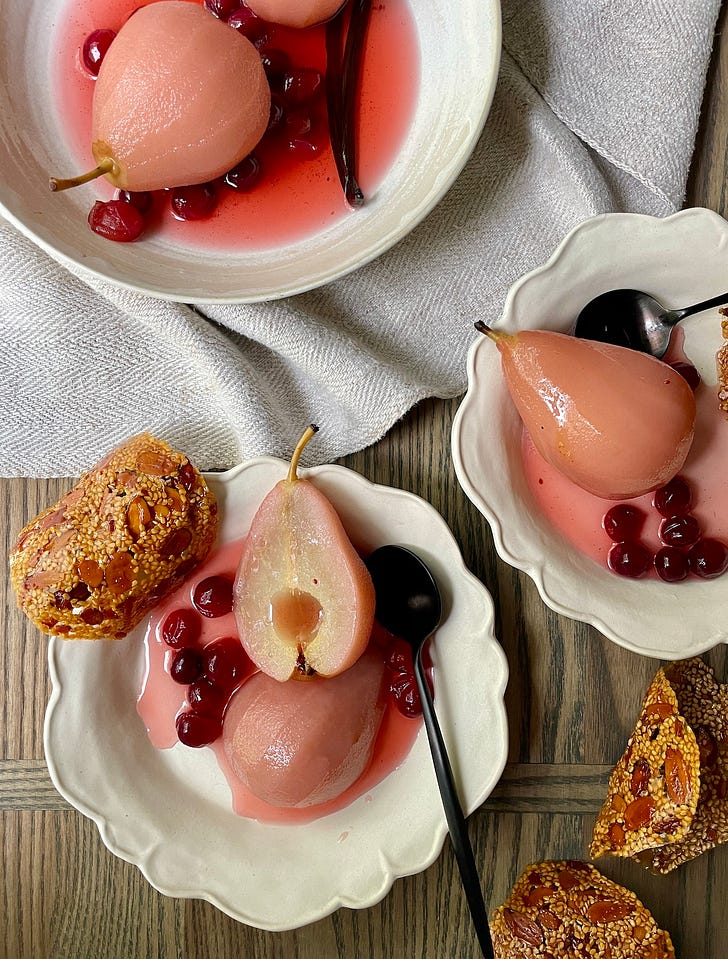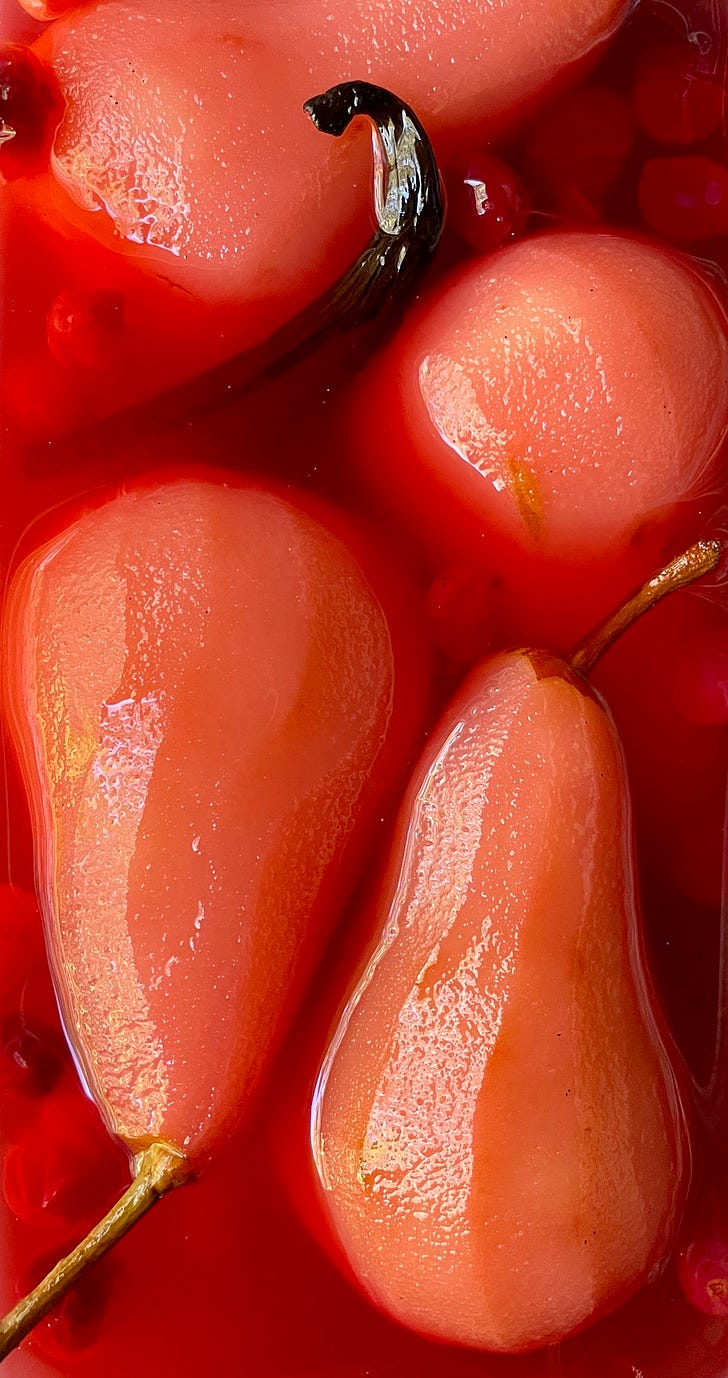
I have always loved poached pears for their elegant simplicity. Also for their ability to serve as dessert all on their own, without leaving you wanting for something richer. A dollop of crème fraîche or scoop of ice cream on the plate — and a nice little cookie on the side — and that is really all you need. Today I offer you a poached pear recipe, and a recipe for Sesame and Almond Tuiles, which are easy to make, and look and taste lovely alongside these pears.
What else do I love about poached pears? They can be made up to a week (or maybe more, but you didn’t hear it from me) in advance of when you want to serve them. They just hang out in the fridge getting better until it’s time to serve.
Here’s another thing to ponder. If the idea of a poached pear doesn’t excite you, consider baking them into a tart or galette. The gentle poaching adds flavor and moisture to the fruit, which can sustain another 30 to 60 minutes in the oven, no problem, and they’re ready to go. Just slice them up, or halve them, and go from there. Or you could make pear dumplings, wrapping the whole pears (upright) with pie dough, and baking until the pastry is golden and crisp. Before wrapping, scoop out the seeds from the bottom using a melon baller and tuck some dried fruit inside there for a little surprise.
You don’t need perfectly ripe pears to make poached pears — in fact, slightly hard pears work better. Even hard-as-a-rock pears work. I often use Bosc pears for poached pears, because I love their sinuous shape, but I rarely would pick one up to eat because it seems like they never ripen and I don't love the gritty skin. Neither is an issue here. If you do use riper pears, you will need to shorten the cooking time significantly, keeping in mind that the pears will continue to cook and soften and soak up the poaching liquid in what should be at least a 24-hour rest in the refrigerator.

When I was the pastry chef at Coco Pazzo in the early ‘90s, just before my switch to the media world, I was charged with making Tuscan-ish desserts that went with the menu and the vibe of the restaurant. I recently unearthed a folder of my cryptic recipes from that time, which I had “kinda” been looking for, and remembered a pear tart I used to make. I used poaching liquid from the pears, rather than the usual milk or cream, to make the custard filling. I also reduced the poaching liquid to make a beautiful glaze for the finished tarts. The crust was a crunchy hazelnut crust (though, when I recreated it the other day, I used some almonds too because I didn't have enough hazelnuts), and it was just as delicious as I remembered. After making the pears for this newsletter, I just had to revisit this old tart recipe, and, while it’s not ready for prime time yet, let me know if you’re interested, and we’ll come back to it at a later date!

I hope I’ve inspired you to give these poached pears a try. I like to offer them at Thanksgiving for those who are Just. Too. Full. for dessert, or for gluten-free guests. I have never tried freezing them, but I bet you could!

Some tips for making poached pears:
Peel them from the stem down to the blossom end in long strips, which will create attractive facets on the finished pears.
Always make sure the pears are covered in liquid. Add water as needed — you can always cook it off later.
Use a deep pot that just holds the fruit, rather than a wide one.
Remember that poaching and boiling are not the same thing! Keep them on the lowest possible heat, so the liquid is steaming but not bubbling much.
Gently turn the pears from time to time so both sides are equally exposed to the heat.
Use a pot lid slightly smaller than the pot to keep the pears submerged.
Remember that the pears won’t really look “done” at the end of the cooking time. You can add time if you’re unsure, but if the pears are at all ripe, consider shaving some of that cooking time off instead.
Choose a storage container that will hold the pears snugly, but not too snugly. They should still move freely in the liquid so they don’t get dented by their neighbors.
Once they’re chilled for a day, you can cut them in half and scoop out the seeds with a melon baller before serving.

Cranberry-Rosé Poached Pears
Serves 4
1 ½ cups rosé wine
½ cup granulated sugar
6 small slices fresh ginger
½ vanilla bean, split and scraped
4 firm Bartlett or Bosc pears, peeled
6 cups water (or enough to cover the pears completely)
1 cup fresh or frozen cranberries
Combine the rosé, sugar, ginger, and vanilla in a medium, deep saucepan and bring to a boil to dissolve the sugar.
Add the pears and the water, adding more as needed to cover the pears completely. Return to a simmer. Place a lid from a smaller pot on top of the pears to keep them submerged. Cook over low heat for 30 to 35 minutes, until the pears are slightly softened.
Remove the pears with a slotted spoon to a storage container and turn the heat to high. Boil the poaching liquid until reduced by half, 15 to 20 minutes. Add the cranberries and cook for 3 to 4 minutes, just until they start to split and soften.
Pour the poaching liquid over the pears in the container and cool completely. Chill overnight before serving, or for as long as a week.



